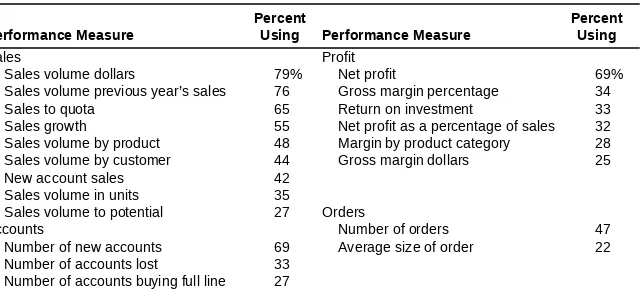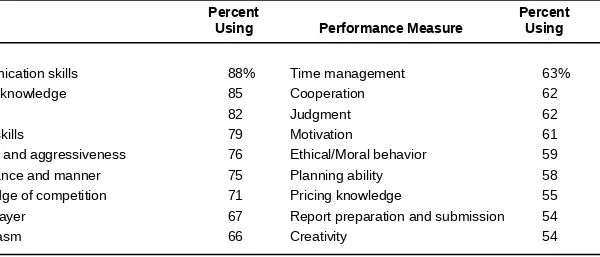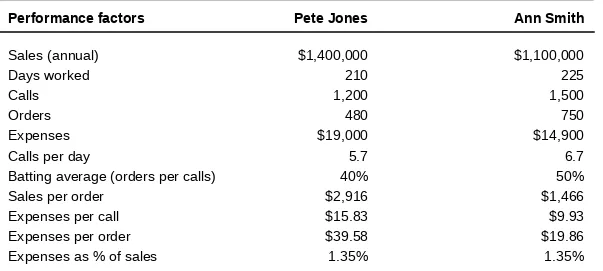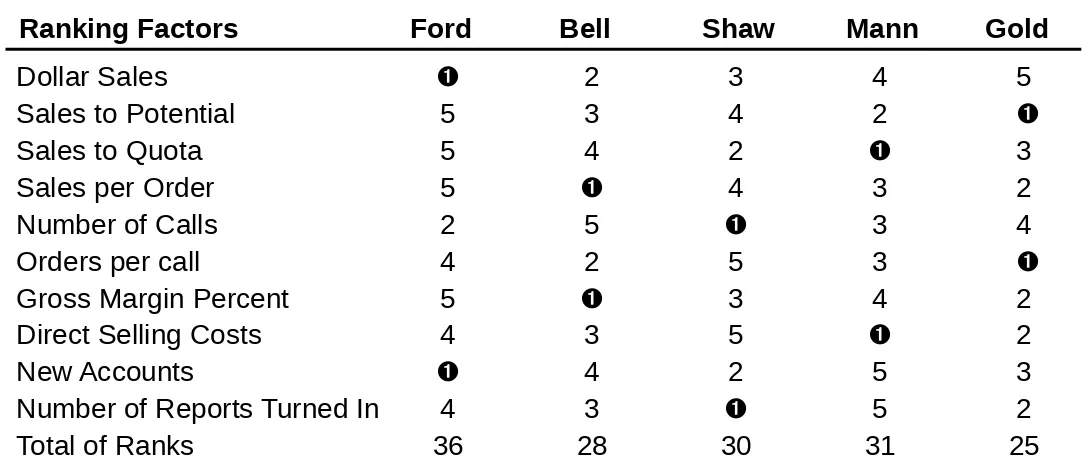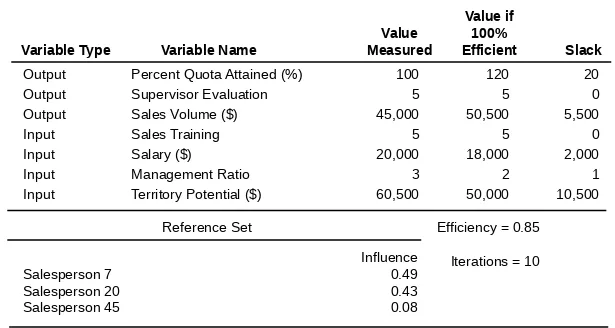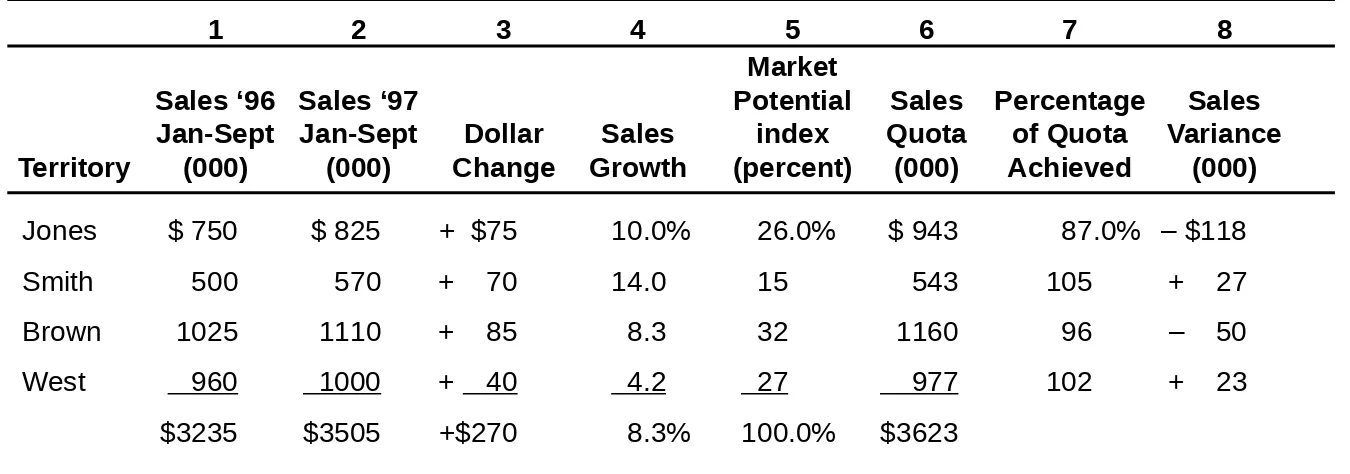Evaluating and Controlling Salespeople
Input system -- Behavioral-based
• Subjective evaluations
– Qualitative measures (Table 16-2) – Use rating scales -- e.g., Likert
– Can have bias & halo effects
• Generating data
– Computerized Call Reports (Fig. 16-3)
– Management by Objectives (MBO)(Fig. 16-4) • non-quantitative -- difficult in solution sales – Behavioral Observation Scales (BOS) (Fig 16-5)
Evaluating and Controlling Salespeople
Combining Input & Output Measures
Call Productivity Ratios
Calls per day = # Calls _ # Days worked
Calls per account = # Calls_ # of Accounts
Planned Call = # Planned calls
Total # Calls
Batting Average = # Orders__
Evaluating and Controlling Salespeople
Combining Input & Output Measures
Expense Ratios
Expense to Sales = Expenses
Sales
Cost per Call = Total Costs
Evaluating and Controlling Salespeople
Combining Input & Output Measures
Account Related Ratios
Sales to Account = Dollar Sales _ # Accounts
Average Order Size = Dollar Sales # Orders
Growth Ratio = # New Accounts Total # Accounts
Account Success = Accounts sold_
Evaluating and Controlling Salespeople
Models Combining Input & Output Controls
Inputs
• Attitude
• Motivation
• Skills
• Abilities
• Job Perception
Inputs
Behavior
• # Calls
• Days worked
• Expenses
• Selling vs. non-
selling time
• Quotas
Outputs
• # Orders
• Order Size
• # New, lost,
Evaluating and Controlling Salespeople
Models Combining Input & Output Controls
• Ranking Procedures
– Widely used, simple to use, easy to understand – Add ranks for overall performance measure – Alternatives to sales/salesperson
• Sales to potential -- good coverage of (limited) market
• Sales to quota -- ability to increase revenue
• Sales per order -- profitability relative to size of customer
• Batting average -- efficiency of calls
• Gross margin percentage -- ability to control price
selling best mix of products
Evaluating Sales Force Performance
Cost Analysis
• What costs are relevant?
Net Sales
Less Variable Costs: Cost of Goods Sold
Sales Commissions
Equals:
Contribution Margin
Less:
Direct Fixed Selling Costs
Evaluating Sales Force Performance
Cost Analysis
• Object affects direct vs. indirect cost class:
Cost
By Territory By Product
P-O-P display Direct Direct Salesperson
Salary Direct Indirect Product Manager
Salary Indirect Direct VP Operations
Evaluating Sales Force Performance
Product Costs
• CGS + Commissions higher for computers
– paying too much for parts
– competition has driven down selling prices
– salespeople cutting computer prices to make
deals -- possible actions:
• limit price negotiation capabilities • shift to a gross margin commission
• change commission structure to emphasize
Evaluating Sales Force Performance
District Costs
• Sales managers vary in ability to control expenses
• 3-way: district by product by cost
– watch for price cutting by salespeople
Evaluating Sales Force Performance
Account Cost to Serve
Total Cost to serve account• Cost to Serve =
• Usually decline with revenue
• Help identify best accounts
• Downsizing & Profits (T 15-7)
• Consider using DEA (Programming)
Table 15-1 Output Measures Used in Sales Force Evaluation
Performance Measure
Percent
Using Performance Measure
Percent Using
Sales
Sales volume dollars
Sales volume previous year’s sales Sales to quota
Sales growth
Sales volume by product Sales volume by customer New account sales
Sales volume in units Sales volume to potential Accounts
Number of new accounts Number of accounts lost
Number of accounts buying full line
79% 76 65 55 48 44 42 35 27 69 33 27 Profit Net profit
Gross margin percentage Return on investment
Net profit as a percentage of sales Margin by product category
Gross margin dollars
Orders
Number of orders Average size of order
69% 34 33 32 28 25 47 22
Table 15-2 Input or Behavior Bases used in Sales Force Evaluation Base Percent Using Base Percent Using
Selling expenses to budget Total expenses
Selling expenses as a % of sales Number of calls
55% 53 49 48
Number of calls per day Number of reports turned in Number of days worked
Selling time vs. nonselling time
42% 38 33 27
Table 15-4 Comparing Dollar and Unit Sales at the Bear Computer Company
Products
Thousands
of Dollars Units
Avg Price Per Unit
Thousands
Of Dollars Units
Avg Price Per Unit Computers Accessories Software $16,800 4,800 2,400 560 4,000 1,200 $30,000 1,200 2,000 $18,200 5,200 2,600 520 4,727 1,280 $35,000 1,100 2,031 Total $24,000 5,760 $26,000 6,527
Table 15-5 Expense Analysis by Product Line, Bear Computer Company, 1997 Products 1997 Sales (000) CGS and Commission $
Table 15-6 Qualitative Bases used in Sales Force Evaluation
Base PercentUsing Performance Measure PercentUsing
Communication skills Product knowledge Attitude
Selling skills
Initiative and aggressiveness Appearance and manner Knowledge of competition Team player Enthusiasm 88% 85 82 79 76 75 71 67 66 Time management Cooperation Judgment Motivation Ethical/Moral behavior Planning ability Pricing knowledge
Report preparation and submission Creativity 63% 62 62 61 59 58 55 54 54
Table 15-8 Measuring Territory Profit Output for Bear Computer Company
Territory Performance (thousands)a
Jones Smith Brown West Net Sales $825 $570 $1100 $1000 Less CGS and Commissions 495 428 754 660 Contribution margin 330 142 356 340 CM as a percentage of sales 40% 25% 325 345 Less direct selling costs
Table 15-9 Evaluating Performance Using Behavior and Outcome Data
Performance factors Pete Jones Ann Smith
Sales (annual) $1,400,000 $1,100,000
Days worked 210 225
Calls 1,200 1,500
Orders 480 750
Expenses $19,000 $14,900
Calls per day 5.7 6.7
Batting average (orders per calls) 40% 50%
Sales per order $2,916 $1,466
Expenses per call $15.83 $9.93
Expenses per order $39.58 $19.86
Table 15-10 Ranking Salespeople on 10 Input/Output factors
Dollar Sales 2 3 4 5
Sales to Potential 5 3 4 2
Sales to Quota 5 4 2 3
Sales per Order 5 4 3 2
Number of Calls 2 5 3 4
Orders per call 4 2 5 3
Gross Margin Percent 5 3 4 2 Direct Selling Costs 4 3 5 2
New Accounts 4 2 5 3
Number of Reports Turned In 4 3 5 2
Total of Ranks 36 28 30 31 25
Figure 15-3 Ranking Salespeople on 10 Input/Output factors 3.87 3.66 3.44 3.23 3.02 2.80 2.59 2.38 2.16 1.95 1.74 1.53 1.31 1.10 COMPROMISERS
Avg sales $3.17 Avg contribution $1.13 Avg contribution % 35.8
Age 45
Calls 1122
Number of salespeople 18
STARS
Avg sales $2.91 Avg contribution $1.09 Avg contribution % 37.4
Age 37
Calls 888
Number of salespeople 11
Avg sales $1.78 Avg contribution $ .64 Avg contribution % 35.8
Age 44
Calls 958
Number of salespeople 11
LAGGARDS
Avg sales $2.03 Avg contribution $ .75 Avg contribution % 37.1
Age 35
Calls 921
Number of salespeople 16
SLOWPOKES Millions
$
Contribution Margin (%)
Table 15-11 Relative performance efficiency for Sales Rep 22
Value if Value 100%
Variable Type Variable Name Measured Efficient Slack
Output Percent Quota Attained (%) 100 120 20 Output Supervisor Evaluation 5 5 0 Output Sales Volume ($) 45,000 50,500 5,500
Input Sales Training 5 5 0
Input Salary ($) 20,000 18,000 2,000
Input Management Ratio 3 2 1
Input Territory Potential ($) 60,500 50,000 10,500
Influence
Salesperson 7 0.49
Salesperson 20 0.43
Salesperson 45 0.08
Reference Set Efficiency = 0.85
Iterations = 10
Figure 15-2 A Model of Salesperson Evaluation
Input-based System
Behavior Calls Reports Complaints Demonstrations Dealer meetings Display set up
Travel/entertainment expenses
Results
Sales revenues Sales growth Sales/quota Sales/potential New accounts
Contribution margins Contribution
percentage
Output-based System
Table 15-7 Measuring Sales Force Output for Bear Computer Company
1 2 3 4 5 6 7 8
Market
Sales ‘96 Sales ‘97 Potential Sales Percentage Sales Jan-Sept Jan-Sept Dollar Sales index Quota of Quota Variance Territory (000) (000) Change Growth (percent) (000) Achieved (000)
Jones $ 750 $ 825 + $75 10.0% 26.0% $ 943 87.0% – $118 Smith 500 570 + 70 14.0 15 543 105 + 27 Brown 1025 1110 + 85 8.3 32 1160 96 – 50 West 960 1000 + 40 4.2 27 977 102 + 23
Figure 15-1: A Sales Force Evaluation Model
Set goals and objectives for sales force, including:
Revenues
Contribution profits Market share
Expense ratios
Design sales plan
Set product performance standards for: Organization Salespeople Regions Accounts Districts
Measure results against
Evaluating Sales Force Performance
Fleet Car Management -- A Motivator
• Salesperson owned car
(
per mile travel allowance)– Salesperson gets car preference
– Allowances rarely cover full salesperson car costs
• Company owned & managed cars
– Ties up a lot of cash
– Costs less than salesperson owned car
• Leased sales fleet of cars
– Frees up cash
Evaluating and Controlling Salespeople
Models Combining Input & Output Controls
• Four Factor Model
– How can sales be increased?
– Optimum Number of sales calls to maximize profits? – Who is doing best? Ann or Pete?
– What management strategies for Pete? for Ann?
$ Sales = Days worked x Calls Orders Sales $ Days Worked Calls Orders
$ Sales = Days worked x Call Rate Batting
Average
Evaluating Sales Force Performance
Profitability Analysis
Full Cost
Sales
Less: C of GS
Equals: Gross Margin
Less: Operating Expenses (Direct +
Indirect Allocated)
Equals: Profit Contribution
Contribution Margin
Sales
C of GS & Other Variables Costs
Contribution Margin
Direct Allocable
Fixed Selling Costs
Evaluating Sales Force Performance
Profitability Analysis
• “Full Cost” Approach
– charge recruiting, training, sales promo &
other marketing expenses to sales manager
– allocation is somewhat arbitrary
Evaluating Sales Force Performance
In-Class Exercise 15-1 --
“Which Profits?” 1. Why would a company that used to use onlysales as a performance criteria for its sales force wish to consider profitability?
2. What criteria should be established to construct a workable performance evaluation system?
3. What are the pros and cons of alternative profit measures?
Evaluating and Controlling Salespeople
In-Class Exercises 16-1
“I Know These Sales Figures Stink” 1. What activities should be completed in the
performance evaluation process?
2. What should take place prior to a performance review meeting?
3. What is covered in the meeting?
4. What to do if an employee disagrees with the performance ratings?
Evaluating and Controlling Salespeople
In-Class Exercises 16-1
“I Know These Sales Figures Stink” 6. How do you handle hostile reactions?
7. What additional questions should Sherrie ask of the veteran sales manager?
8. What consideration should be given to a large customer going out of business?
9. Is sales, the bottom line, the only measure that should be used for evaluating performance?
Evaluating and Controlling Salespeople
Input vs. Output Systems
Salary Compensation Commission
Evaluating and Controlling Salespeople
Using Judgment Models -- Ranking Procedures
1
. How do the six salespeople compare with oneanother? -- Rank them for 1 to 6 overall.
2. Which of the six would you promote to Field
Sales Supervisor (sales manager position)?
3. If you were opening a new territory which is
promising to be quite high in sales potential and thus both lucrative and challenging, and you had to assign one of the six to that territory, which
Evaluating and Controlling Salespeople
Using Judgment Models -- Ranking Procedures
4. If you had to reduce the sales force to only 5
salespeople, and thus had to terminate one of the
salespeople, which one would you terminate? Why?
5. If you had a $10,000 budget for bonuses for your
sales force and had to pay it all out, how much of the $10,000 would you give to each of the
Evaluating and Controlling Salespeople
Using Judgment Models -- Ranking Procedures
• Results of a sample of 242 sales managers
– How do your results compare with the
managers?
– Situation specific evaluations
– Overall evaluations
– Situation Specific Predictive Ability
Evaluating and Controlling Salespeople
Using Judgment Models -- Ranking Procedures
1
. How do the six salespeople compare with oneanother? -- Rank them for 1 to 6 overall.
2. Which of the six would you promote to Field
Sales Supervisor (sales manager position)?
3. If you were opening a new territory which is
promising to be quite high in sales potential and thus both lucrative and challenging, and you had to assign one of the six to that territory, which
Evaluating and Controlling Salespeople
Using Judgment Models -- Ranking Procedures
4. If you had to reduce the sales force to only 5
salespeople, and thus had to terminate one of the
salespeople, which one would you terminate? Why?
5. If you had a $10,000 budget for bonuses for your
sales force and had to pay it all out, how much of the $10,000 would you give to each of the
Evaluating and Controlling Salespeople
Using Judgment Models -- Ranking Procedures
• Results of a sample of 242 sales managers
– How do your results compare with the
managers?
– Situation specific evaluations
– Overall evaluations
– Situation Specific Predictive Ability
Evaluating and Controlling Salespeople
Summarizing Sales force Performance
• Performance Matrix
– Shows interaction of 3 or more variables at a time – Identifies reps for rewards and punishments
– Helps find subtle interactions
– Findings in Figure 16-6
• Reps begin career selling high margin mix of products
• Reps end career by sacrificing margins for revenue • Laggards represent a plateauing problem
• Laggards should make more contractor calls
• If looking for $$ -- reward compromisers
Evaluating Sales Force Performance
Profitability Analysis
• Residual Income Analysis
– Sales growth is desirable as long as
profits exceed cost of capital
– Most comprehensive single measure of
sales force performance
– Existing control factors all included
– Expressed in dollars makes it easier to set
sales manager incentives
Evaluating Sales Force Performance
Profitability Analysis
• Return on Assets Managed (ROAM)
Profit Contrib.
Sales
Sales
Assets Managed
• Assets under sales management control
• District Analysis
– Assets managed poorly in District 4
– Profit contribution greatest in District 1
Evaluating Sales Force Performance
Profitability Analysis
• ROAM disadvantages
– focus on lower assets (inventory + acct. receivable)
– does not consider sales level or growth
• Solution: Residual Income Analysis (RIA)
Profit Contribution
Less: Acct receivable costs
Inventory carrying costs
Evaluating Sales Force Performance
Sales Force Evaluation Model
• Sales Analysis Principles
– 80/20 -- 20% of customers yield 80% sales
– Iceberg -- sales figures tip of iceberg -- need more
• Gathering Sales Data
– DSS
– hand held computers for field
• Steps in Sales Analysis
– Pick unit for analysis - by division, district, etc.
Evaluating Sales Force Performance
• The Big Picture– Start with aggregate sales by year
– Look for changes and trends -- market share, volume
• Refining through Cross Classification
– Sales by Region
• reward areas of strength? • move into areas of weakness
– Sales by Product Line
• Are you selling what firm wants? or what
salespeople want?
Evaluating Sales Force Performance
• Refining Through Cross Classification
– Dollar Vs. Unit Sales
• When price change (inflation) distorts dollar
figures
• Good for big ticket items
– Sales by Distribution Channel
• tends to change over time
• asks who customers really are
– Sales by Customer Type
• illustrates 80/20 principle
Evaluating Sales Force Performance
• Cross Classification Techniques
– Multi-way Tables
– Varying Customer Classifications
– Product Lines vs. Product Categories
Table 15-3 Sales Data for Bear Computer Company
1 2 3 4
Company Percentage Industry Company Volume Change from Volume Market Share Year ($ millions) Previous Year ($ millions) (percent)
1997 26 + 8.3 300 8.6
1996 24 +14.3 219 10.9
1995 21 +23.5 165 15.7
Table 15-7 Measuring Sales Force Output for Bear Computer Company
1 2 3 4 5 6 7 8
Market
Sales ‘96 Sales ‘97 Potential Sales Percentage Sales Jan-Sept Jan-Sept Dollar Sales index Quota of Quota Variance Territory (000) (000) Change Growth (percent) (000) Achieved (000)
Jones $ 750 $ 825 + $75 10.0% 26.0% $ 943 87.0% – $118 Smith 500 570 + 70 14.0 15 543 105 + 27 Brown 1025 1110 + 85 8.3 32 1160 96 – 50 West 960 1000 + 40 4.2 27 977 102 + 23
Figure 15-3 Ranking Salespeople on 10 Input/Output factors 3.87 3.66 3.44 3.23 3.02 2.80 2.59 2.38 2.16 1.95 1.74 1.53 1.31 1.10 COMPROMISERS
Avg sales $3.17 Avg contribution $1.13 Avg contribution % 35.8
Age 45
Calls 1122
Number of salespeople 18
STARS
Avg sales $2.91 Avg contribution $1.09 Avg contribution % 37.4
Age 37
Calls 888
Number of salespeople 11
Avg sales $1.78 Avg contribution $ .64 Avg contribution % 35.8
Age 44
Calls 958
Number of salespeople 11
LAGGARDS
Avg sales $2.03 Avg contribution $ .75 Avg contribution % 37.1
Age 35
Calls 921
Number of salespeople 16
SLOWPOKES Millions
$
Contribution Margin (%)
